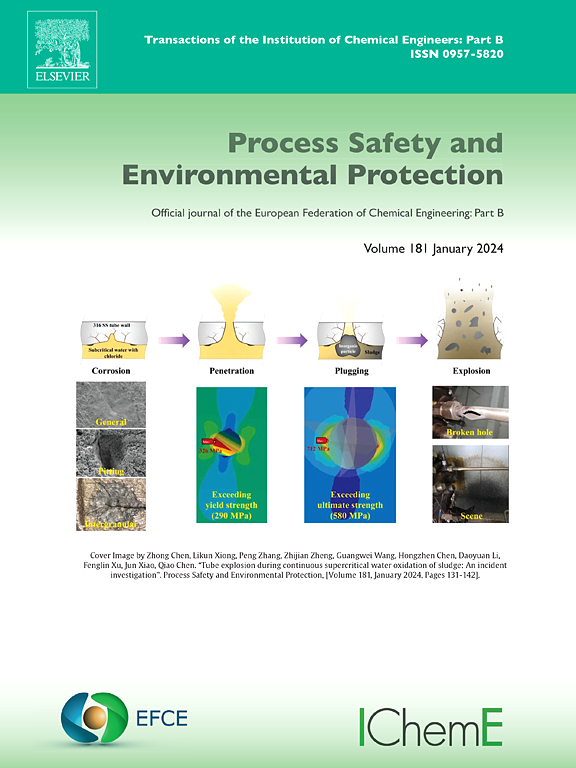Mineralogical insights into the release behaviors of potentially toxic elements from the indigenous Zn smelting slags dumping sites
IF 7.8
2区 环境科学与生态学
Q1 ENGINEERING, CHEMICAL
引用次数: 0
Abstract
Limited studies focus on the leaching behaviors of potentially toxic elements (PTEs) in smelting slags dumping sites, based on mineralogical information and geochemical modelling. In this study, the occurrence patterns of PTEs were identified using mineral liberation analyzer (MLA) and Tessier speciation extraction method, and their release mechanisms were studied via the leaching tests and PHREEQC modelling. The results indicated that 60.33 % of kaolinite, 23.19 % of quartz and 1.36 % of limonite were found in soils, whereas 25.38 % of quartz, 25.86 % of biotite, and 21.54 % of Fe and Al- bearing oxides existed in smelting slags. 0.34–64.54 % of As, Cd, Mn, Pb and Zn were presented in the labile fractions, and coexisted with silicate and oxide minerals. The effects of smelting slag additions on PTEs release from soil-slag mixing systems were more obvious under extremely acidic (pH < 4) and alkaline (pH > 10.5) environment. PTEs release process was best fitted by the double constant rate equation in column leaching tests (R2 > 0.92). PHREEQC results further showed that the dissolution and precipitation of PTEs hosting minerals were the potential factors to control PTEs release. Overall, this study was of great significance to pollution control and environmental management in smelting slags dumping sites.
本地锌冶炼渣倾倒场潜在有毒元素释放行为的矿物学研究
有限的研究主要集中在矿物学信息和地球化学模拟的基础上,研究冶炼渣倾倒场中潜在有毒元素(pte)的浸出行为。本研究采用矿物释放分析仪(MLA)和Tessier形态提取法确定了pte的赋存模式,并通过浸出试验和PHREEQC模型研究了pte的释放机制。结果表明,土壤中高岭石含量为60.33%,石英含量为23.19%,褐铁矿含量为1.36%,冶炼渣中石英含量为25.38%,黑云母含量为25.86%,含铁、含铝氧化物含量为21.54%。As、Cd、Mn、Pb、Zn的含量为0.34 ~ 64.54%,存在于不稳定组分中,与硅酸盐、氧化矿物共存。在极酸性条件下(pH <;4)碱性(pH >;10.5)环境。柱浸试验中PTEs的释放过程最适合采用双恒速率方程(R2 >;0.92)。PHREEQC结果进一步表明,pte承载矿物的溶解和沉淀是控制pte释放的潜在因素。综上所述,本研究对冶炼渣倾倒场的污染控制和环境管理具有重要意义。
本文章由计算机程序翻译,如有差异,请以英文原文为准。
求助全文
约1分钟内获得全文
求助全文
来源期刊

Process Safety and Environmental Protection
环境科学-工程:化工
CiteScore
11.40
自引率
15.40%
发文量
929
审稿时长
8.0 months
期刊介绍:
The Process Safety and Environmental Protection (PSEP) journal is a leading international publication that focuses on the publication of high-quality, original research papers in the field of engineering, specifically those related to the safety of industrial processes and environmental protection. The journal encourages submissions that present new developments in safety and environmental aspects, particularly those that show how research findings can be applied in process engineering design and practice.
PSEP is particularly interested in research that brings fresh perspectives to established engineering principles, identifies unsolved problems, or suggests directions for future research. The journal also values contributions that push the boundaries of traditional engineering and welcomes multidisciplinary papers.
PSEP's articles are abstracted and indexed by a range of databases and services, which helps to ensure that the journal's research is accessible and recognized in the academic and professional communities. These databases include ANTE, Chemical Abstracts, Chemical Hazards in Industry, Current Contents, Elsevier Engineering Information database, Pascal Francis, Web of Science, Scopus, Engineering Information Database EnCompass LIT (Elsevier), and INSPEC. This wide coverage facilitates the dissemination of the journal's content to a global audience interested in process safety and environmental engineering.
 求助内容:
求助内容: 应助结果提醒方式:
应助结果提醒方式:


